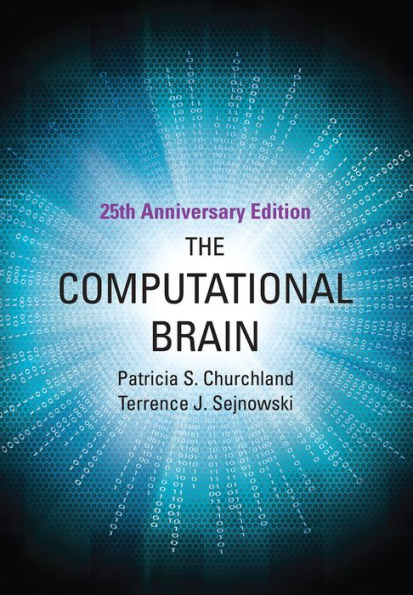
The Computational Brain, 25th Anniversary Edition
568
The Computational Brain, 25th Anniversary Edition
568Paperback(25th Anniversary Edition)
-
PICK UP IN STORECheck Availability at Nearby Stores
Available within 2 business hours
Related collections and offers
Overview
Before The Computational Brain was published in 1992, conceptual frameworks for brain function were based on the behavior of single neurons, applied globally. In The Computational Brain, Patricia Churchland and Terrence Sejnowski developed a different conceptual framework, based on large populations of neurons. They did this by showing that patterns of activities among the units in trained artificial neural network models had properties that resembled those recorded from populations of neurons recorded one at a time. It is one of the first books to bring together computational concepts and behavioral data within a neurobiological framework. Aimed at a broad audience of neuroscientists, computer scientists, cognitive scientists, and philosophers, The Computational Brain is written for both expert and novice. This anniversary edition offers a new preface by the authors that puts the book in the context of current research.
This approach influenced a generation of researchers. Even today, when neuroscientists can routinely record from hundreds of neurons using optics rather than electricity, and the 2013 White House BRAIN initiative heralded a new era in innovative neurotechnologies, the main message of The Computational Brain is still relevant.

Product Details
| ISBN-13: | 9780262533393 |
|---|---|
| Publisher: | MIT Press |
| Publication date: | 11/04/2016 |
| Series: | Computational Neuroscience Series |
| Edition description: | 25th Anniversary Edition |
| Pages: | 568 |
| Sales rank: | 834,744 |
| Product dimensions: | 6.90(w) x 9.90(h) x 1.20(d) |
| Age Range: | 18 Years |
About the Author
Terrence J. Sejnowski holds the Francis Crick Chair at the Salk Institute for Biological Studies and is a Distinguished Professor at the University of California, San Diego. He was a member of the advisory committee for the Obama administration's BRAIN initiative and is President of the Neural Information Processing (NIPS) Foundation. He is the author of The Deep Learning Revolution (MIT Press) and other books.
Table of Contents
Series Foreword vii
25th Anniversary Preface ix
Preface xvii
1 Introduction 1
2 Neuroscience Overview 17
Introduction 17
Levels in nervous systems 18
Structure at various levels of organization 27
A short list of brain facts 48
3 Computational Overview 61
Introduction 61
Looking up the answer 69
Linear associators 77
Constraint satisfaction: Hopfield networks and Boltzmann machines 82
Learning in neural nets 96
Competitive learning 102
Curve fitting 105
Feedforward nets: Two examples 107
Recurrent nets 115
From toy world to real world 125
What good are optimization procedures to neuroscience? 130
Models: Realistic and abstract 136
Concluding remarks 137
4 Representing the World 141
Introduction 141
Constructing a visual world 142
Thumbnail sketch of the mammalian visual system 148
Representing in the brain: What can we learn from the visual system? 157
What is so special about distribution? 163
World enough and time 174
Shape from shading: A neurocomputational study 183
Stereo vision 188
Computational models of stereo vision 199
Hyperaciiity: From mystery to mechanism 221
Vector averaging 233
Concluding remarks 237
5 Plasticity: Cells, Circuits, Brains, and Behavior 239
Introduction 239
Learning and the hippocampus 243
Donald Hebb and synaptic plasticity 250
Memories are made of this: Mechanisms of neuronal plasticity 254
Cells and circuits 281
Decreasing synaptic strength 289
Back to systems and behavior 295
Being and timing 305
Development of nervous systems 307
Modules and networks 316
6 Sensorimotor Integration 331
Introduction 331
LeechNet 341
Computation and the vestibulo-ocular reflex 353
Time and time again 379
The segmental swimming oscillator 388
Modeling the neuron 399
Concluding remarks 411
7 Concluding and Beyond 413
Afterword 425
Appendix: Anatomical and Physiological Techniques 427
Permanent lesions 427
Reversible lesions and microlesions 430
Imaging techniques 432
Gross electrical and magnetic recording 437
Single-unit recording 440
Anatomical tract tracing 442
Notes 445
Glossary 457
References 479
Index 525
What People are Saying About This
The authors have successfully integrated a number of diverse disciplines into a coherent picture of the field. The Computational Brain is a major contribution.
— Carver Mead , Gordon and Betty Moore Professor of Computer Science, California Institute of TechnologyThe Computational Brain describes the new style of brain-like computation, based on neural nets, as it applies to biological systems. It is written in a lively, readable style, assisted by many illustrations, yet it does not evade the many intellectual and computational problems involved. It is unique in viewing the subject from such a wide perspective while presenting detailed examples to illustrate the present state of the art. I strongly recommend it to all those interested in how nervous systems work, including the behavior of our own brain.
— Francis Crick , The Salk InstituteThere is no equivalent to The Computational Brain —a unique synthesis of the fast expanding field of neural model. A rewarding experience to read.
— J. P. Changeux , Institut PasteurThe Computational Brain documents a revolution now occurring in the neurosciences. For the past two centuries, the mainstream approach to brain and behavior has been biomedical, usurped from philosophers first by nineteenth-century neurologists, then by psychiatrists and behavioral psychologists, and now by neuropharmacologists and by cell and molecular biologists. Since the publication of Rumelhart and McClelland's Parallel Distributed Processing: Explorations in the Microstructure of Cognition in 1986, the current is slowly turning back to epistomologists whose central paradigm is communications and information processing. The Computational Brain presents contemporary neuroscience panoramically from this revolutionary point of view. It is essential reading for anyone interested in neuroscience, which has been called the last frontier of biology, not only because it explains the relevance of computation to neurobiology with extraordinary clarity, but also because the book shows unambiguously that both frontier and center are moving.
— James H. Schwartz, MD, PhD , Center for Neurobiology & Behavior, Columbia University